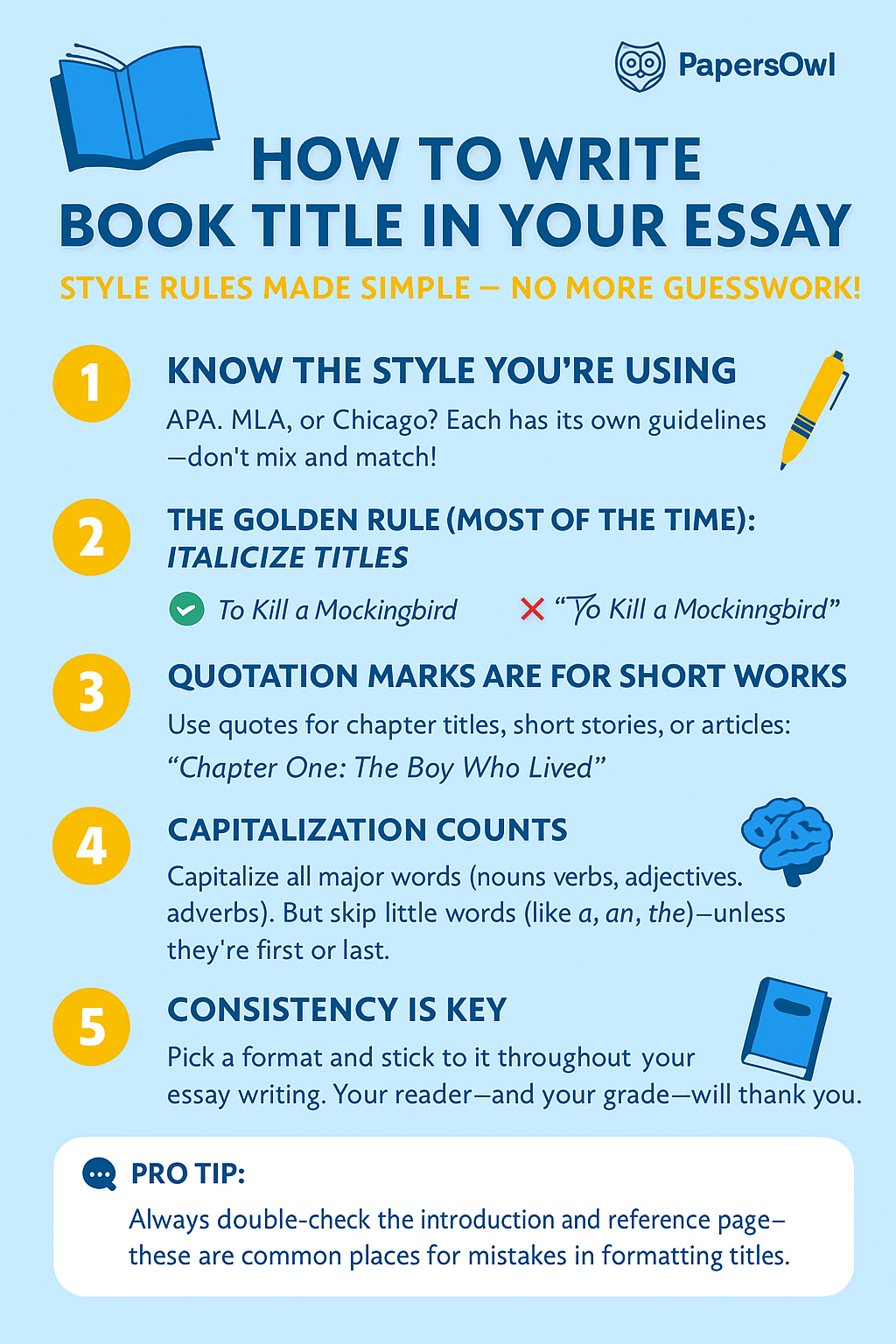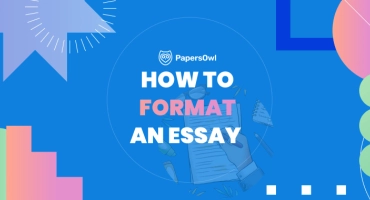How to Write a Book Title in an Essay: Style Guidelines and Examples
Table of contents
- 1 ✅ Mini-Checklist on How to Write Book Titles in Essays
- 2 📚 APA Style Guide
- 3 📚 MLA (Modern Language Association) Style Guide
- 4 📚 Chicago Style Guide
- 5 📊 Comparison Table: APA vs MLA vs Chicago
- 6 📚 Writing Various Types of Titles
- 7 📚 Visual Examples of Correctly Formatted Paragraphs in Different Styles
- 8 Most Common Mistakes
- 9 📘 Micro-Glossary
- 10 Final Thoughts
When writing an academic essay, it’s important to know how to write a book title in your essay. Should you use italics, quotation marks, or underlining? The answer depends on the formatting you are using. Each set of citation guidelines has its guidelines. If these rules are too complicated or time-consuming to follow perfectly, you can always order an essay paper from professionals.
As a general rule, the title of a book or any novel should be in italics. Titles of shorter works, like sections or journal articles in a larger work, should be in double quotation marks (use single quotation marks only within a quote). These rules can get confusing. That’s why many students turn to professional writers for guidance on design and structure.
If you have a complex paper, consider getting help. An college application essay writing service can help you write your sources correctly and save time.
This guide will teach you how to introduce a book in an essay.
✅ Mini-Checklist on How to Write Book Titles in Essays
- ✅ Check your required citation layout (APA, MLA, or Chicago).
- ✅ APA Style:
– Italicize full book titles.
– Use (” “) for sections of a larger work or article titles.
Examples: The Rape of Nanking by Iris Chang. “The Forgotten Holocaust” is a section in The Rape of Nanking.
- ✅ MLA Style:
– Italicize complete titles of books and publications.
– Use (” “) for journal articles, short stories, or poems.
Examples: Harper Lee explores justice in To Kill a Mockingbird. The essay “On Compassion” is found in The Norton Reader.
- ✅ Chicago Style:
– Italicize book titles and publications.
– Use (” “) for section titles.
Examples: The Great Gatsby was published in 1925. In the section “The Valley of Ashes,” Fitzgerald describes decay.
- ✅ Use capital letters for major words in titles (capitalize nouns, verbs, adjectives, adverbs, and pronouns).
- ✅ Do not underline book name in typed essays. Underline only if handwritten.
- ✅ Avoid mixing styles in the same essay. Stick to one formatting rule consistently.
- ✅ Refer to official citation guidelines when in doubt.

📚 APA Style Guide
There are some basic principles on how to quote a book title in an essay in the APA approach.
✅ General Guidelines:
- Book name: Italicized
- Titles of sections within books: “In quotation marks”
- Only capitalize the initial word of the title and subtitle, and any proper nouns
- Do not capitalize coordinating conjunctions, articles, or prepositions unless they begin the title
✍️ Examples in Sentences:
- In The Rape of Nanking, Iris Chang explores the atrocities committed during World War II.
- The section “Facing History” in Teaching Community by bell hooks emphasizes the role of storytelling in education.
- In Thinking, Fast and Slow, Daniel Kahneman breaks down two systems of thought that shape human decisions.
- According to The Elements of Style: Grammar for Everyone, clarity is key in effective writing.
🧠 Quick Reminders:
- Always italicize the complete book title when writing essays in APA style.
- Use quotation marks only for sections, short stories, or journal articles.
- Follow APA citation guidelines when referencing the work in your reference list (e.g., last name, initial, year).
APA Format Essay: Writing The Name of The Author
✅ General Guidelines for Author Names
- Single Author: Always use the author’s full name (e.g., Smith, John).
- Multiple Authors: List all authors with their last names first, followed by the initials of their first names (e.g., Smith, J., & Jones, M.).
- Three or More Authors: For three or more authors, only use the initials of their first names (e.g., Johnson, M.C., Carlson, M., & Smith, J.N.).
✍️ Example:
- One Author: Smith, John.
- Two Authors: Johnson, M., & Carlson, M.
- Three or More Authors: Johnson, M.C., Carlson, M., Smith, J.N., & Hanover, L.E.
📚 MLA (Modern Language Association) Style Guide
The following guidelines will instruct you on how to write the title of a book in an essay in MLA style:
✅ General Guidelines
- Book name: Italicized
- Titles of sections within books: “In Quotation Marks”
- Capitalize the first word of the title and subtitle, as well as any proper nouns
- Do not capitalize articles, short conjunctions, or prepositions unless they begin the title
✍️ Examples in Sentences
- In The Great Gatsby, Nick Carraway reflects on the illusion of the American Dream.
- The section “The Importance of Being Earnest” in The Art of Fiction examines the role of comedy in literature.
- In Pride and Prejudice, Jane Austen challenges societal norms about marriage and class.
- According to The Odyssey: An Epic Poem, Homer’s narrative explores themes of heroism and adventure.
🧠 Quick Reminders
- Always italicize the title of the book in MLA style.
- Apply quotation marks for the titles of short stories, articles, and essays.
- When listing sources in your Works Cited page, follow the MLA Handbook guidelines — for example, last name, first name, book title, publisher, and year.
MLA Style Essay: Writing the Name of the Author
✅ General Guidelines for Author Names
- Single Author: Use the full name of the author (e.g., Smith, John).
- Multiple Authors: List the authors in the order they appear in the book, with the first author’s full name followed by the others’ last names and initials (e.g., Smith, John, and Jane Doe).
- Three or More Authors: Use the first author’s full name followed by “et al.” (e.g., Smith, John, et al.).
✍️ Example:
- One Author: Smith, John.
- Two Authors: Smith, John, and Jane Doe.
- Three or More Authors: Smith, John, et al.
Сheck my paper

📚 Chicago Style Guide
To write a good book title, follow these steps according to the Chicago Manual:
✅ General Guidelines
- Book Name: Italicize the title.
- Chapter titles or sections within books: “In Quotation Marks”
- Capitalize the first letter of the title and subtitle, and any proper nouns
- Do not capitalize articles, short conjunctions, or prepositions unless they begin the title
✍️ Examples in Sentences
- In The Catcher in the Rye, J.D. Salinger delves into the struggles of adolescence.
- The chapter “The Making of a Leader” in Leadership Principles offers advice on navigating difficult decisions.
- In Beloved, Toni Morrison explores memory, trauma, and identity themes in post-Civil War America.
- According to A Brief History of Time, Stephen Hawking explains complex concepts in physics for a general audience.
🧠 Quick Reminders
- Always italicize the full title of a book or a novel.
- Apply quotation marks for chapter titles, short stories, articles, and essays.
- Ensure you follow the guidelines when referencing the work in your bibliography (e.g., last name, first name, title of book, publisher, year, page numbers if applicable).
Chicago Style Essay: Writing the Name of the Author
✅ General Guidelines for Author Names
- Single Author: Use the full name of the author (e.g., Smith, John).
- Multiple Authors: List the authors in the order they appear on the title page, with the first author’s full name followed by the other authors’ first and last names (e.g., Smith, John, and Jane Doe).
- Three or More Authors: Use the first author’s full name followed by “et al.” (e.g., Smith, John, et al.).
✍️ Example:
- One Author: Smith, John.
- Two Authors: Smith, John, and Jane Doe.
- Three or More Authors: Smith, John, et al.
📊 Comparison Table: APA vs MLA vs Chicago
Skilled writers often follow these specific rules on how to write a title of a book in an essay to maintain consistency and professionalism in their work.
| Feature | APA | MLA | Chicago |
| Book Titles | Italicized | Italicized | Italicized |
| Chapter Titles | “In Quotation Marks” | “In Quotation Marks” | “In Quotation Marks” |
| Capitalization Rule | Capitalize major words + the first word + after the colon | Capitalize major words | Capitalize major words + the first word |
| Punctuation Marks | No punctuation marks after italicized title | No punctuation marks after the title | Comma after title if followed by author name |
| Used In | Social sciences, psychology, education | Humanities, literature, arts | History, fine arts, publishing |
| Example | The Road to Character by David Brooks | The Road to Character by David Brooks | The Road to Character, by David Brooks |
| Chapter Example | “Humility Code” in The Road to Character | “Humility Code” in The Road to Character | “Humility Code,” in The Road to Character |
📚 Writing Various Types of Titles
Now that we’ve covered how to format a book title in an essay, let’s look at how titles can be written differently.
Here are some key guidelines for writing titles:
- Book Titles: Use italics and capitalize the main words.The Secret Garden by Frances Hodgson Burnett.
- Author and Other Works: Italicize and capitalize the name of the author and their other works when mentioned in a book title. Jane Austen’s Pride and Prejudice (1813).
- Short Titles (e.g., poems, articles, short stories): Use quotation marks around. “The Road Not Taken” by Robert Frost.
Before deciding on the style, it’s important to understand the main idea you want to convey in your essay. If you’re looking for help writing your essay, you can always consider essay papers for sale to guide you on how to put a book title in an essay and help you accomplish your writing goals effectively.

📚 Visual Examples of Correctly Formatted Paragraphs in Different Styles
✅ APA Style
✅ MLA Style
✅ Chicago Style (Notes and Bibliography)
^1 J.D. Salinger, The Catcher in the Rye (Boston: Little, Brown, 1951); Erik H. Erikson, Identity: Youth and Crisis (New York: Norton, 1968); Tara Westover, Educated (New York: Random House, 2018); Michelle Obama, Becoming (New York: Crown, 2018); Jeffrey Arnett, On Becoming an Adult (Cambridge: Cambridge University Press, 2015); Harper Lee, To Kill a Mockingbird (Philadelphia: J.B. Lippincott & Co., 1960); Ralph Ellison, Invisible Man (New York: Random House, 1952).
Most Common Mistakes
1. Mixing Up Citation Styles
Mixing up layouts can also lead to inconsistent or incorrect entries on your Works Cited page.
- ❌ The Catcher in the Rye by J.D. Salinger (MLA) and “Thinking, Fast and Slow” by Daniel Kahneman (APA)
- ✅ Stick to one style: The Catcher in the Rye and Thinking, Fast and Slow (MLA)
2. Forgetting Italics or Quotation Marks
Titles of entire works (like books) should be italicized. Titles of shorter works should be in double quotation marks.
- ❌ In The Great Gatsby, the chapter “The Party” captures the era’s extravagance.
- ✅ In The Great Gatsby, the chapter “The Party” captures the era’s extravagance. (APA)
- ❌ One of my favorite parts is The Hero’s Return from the book.
- ✅ One of my favorite parts is “The Hero’s Return” from the book. (APA/MLA)
3. Inconsistent Formatting Throughout the Paper
Once you write a title one way, keep it consistent every time it appears.
- ❌ First mention: Brave New World; later: “Brave New World”
- ✅ Consistent: Brave New World (MLA/Chicago) — or “Brave New World” (APA)
4. Capitalization Errors
Only the first word and important words (like nouns, verbs, and adjectives) should be capitalized in titles.
- ❌ the lord of the rings
- ✅ The Lord of the Rings
5. Misusing the Question Mark in Titles
Don’t add a question mark to a book title unless it’s actually part of the title itself. For instance:
- ❌ Who Moved My Cheese?
- ✅ Who Moved My Cheese? (Correct — the question mark is part of the title.)
📘 Micro-Glossary
Italics — Slanted text indicates titles of complete works like books, films, or journals in typed essays. 1984 by George Orwell.
Quotation Marks (” “) — Used around shorter works that are part of a larger publication, like articles, short stories, or book chapters. “A Good Man Is Hard to Find” by Flannery O’Connor.
Underline — Used in handwritten essays to represent italics when italic form isn’t available. The Great Gatsby
Final Thoughts
Writing book titles correctly is a small detail that makes a big difference in academic writing. Follow these guidelines based on your citation style; your essays will look polished and professional. Being consistent with formatting shows attention to detail and respect for academic standards. Double-check that the formatting of your works cited matches the chosen style guide.
Whether you’re drafting your research paper in Microsoft Word or another word processor, it’s important to write titles the same way throughout. This applies whether you’re referring to a chapter or the entire book. Don’t forget to include the correct page number when quoting or referencing specific sections — this is especially vital for thoroughness and accuracy.
Many writers overlook these details, but a well-written essay stands out. As a final note, taking the time to get your book titles right reflects your commitment to quality and clarity. And remember, knowing how to title an essay correctly will ensure your work meets the highest standards. Need help citing in Chicago style? Check out our easy-to-use guide to get it right!







